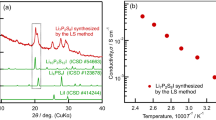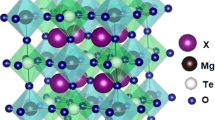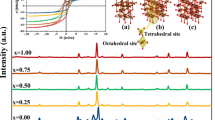Abstract
The series of copper-doped strontium titanate materials with the assumed formula SrTi1−xCuxO3 (where x = 0.01, 0.02, 0.05) were obtained by the sol–gel method. The synthesis of materials was undertaken towards evaluation of the possibility of their application in modern technologies in the field of energy storage and conversion. Materials were obtained in the form of powders and sintered bodies. Both types of these materials were tested for structural (XRD analysis), microstructural (SEM), reduction-oxidizing properties (TPR/TPOx methods). For sinters also electrical properties (conductivity and Seebeck coefficient) were determined. The phase composition analysis and the TPR results showed significant differences between the samples in the form of powders and sinters. The influence of copper oxide melting on the materials properties was observed. The measurements of the Seebeck coefficient confirm that copper is an acceptor dopant for strontium titanate. The results of total conductivity measurements carried out in the air atmosphere indicate that the addition of copper causes an increase in conductivity, with the highest value obtained for the material with the highest amount of copper introduced.







Similar content being viewed by others
References
Fuchs D, Schneider CW, Schneider R, Rietschel H. High dielectric constant and tunability of epitaxial SrTiO3 thin film capacitors. J Appl Phys. 1999;85:7362. https://doi.org/10.1063/1.369363.
Noll F, Münch W, Denk I, Maier J. SrTiO3 as a prototype of a mixed conductor conductivities, oxygen diffusion and boundary effects. Solid State Ion. 1996;86–88:711–7. https://doi.org/10.1016/0167-2738(96)00155-5.
Ramamoorthy R, Dutta PK, Akbar SA. Oxygen sensors: materials, methods, designs and applications. J Mater Sci. 2003;38:4271–82. https://doi.org/10.1023/A:1026370729205.
Mills A, le Hunte S. An overview of semiconductor photocatalysis. J Photochem Photobiol A Chem. 1997;108:1–35. https://doi.org/10.1016/S1010-6030(97)00118-4.
Sudireddy BR, Blennow P, Nielsen KA. Microstructural and electrical characterization of Nb-doped SrTiO3–YSZ composites for solid oxide cell electrodes. Solid State Ion. 2012;216:44–9. https://doi.org/10.1016/j.ssi.2011.11.025.
Okuda T, Nakanishi K, Miyasaka S, Tokura Y. Large thermoelectric response of metallic perovskites: Sr1−xLaxTiO3 (0<~x<~0.1). Phys Rev B. 2001;63:113. https://doi.org/10.1103/PhysRevB.63.113104.
Savaniu CD, Irvine JTS. La-doped SrTiO3 as anode material for IT-SOFC. Solid State Ion. 2011;192:491–3. https://doi.org/10.1016/j.ssi.2010.02.010.
Ohta S, Nomura T, Ohta H, Koumoto K. High-temperature carrier transport and thermoelectric properties of heavily La- or Nb-doped SrTiO3 single crystals. J App Phys. 2005;97:0341061–4. https://doi.org/10.1063/1.1847723.
Li X, Zhao H, Shen W, Gao F, Huang X, Li Y, et al. Synthesis and properties of Y-doped SrTiO3 as an anode material for SOFCs. J Power Sour. 2007;166:47–52. https://doi.org/10.1016/j.jpowsour.2007.01.008.
Drożdż E, Łącz A, Koleżyński A, Mikuła A, Mars K. Experimental and theoretical studies of structural and electrical properties of highly porous Sr1−xYxTiO3. Solid State Ion. 2017;302:173–9. https://doi.org/10.1016/j.ssi.2016.11.014.
Blennow P, Hagen A, Hansen KK, Wallenberg LR, Mogensen M. Defect and electrical transport properties of Nb-doped SrTiO3. Solid State Ion. 2008;179:2047–58. https://doi.org/10.1016/j.ssi.2008.06.023.
Blennow P, Hansen KK, Wallenberg LR, Mogensen M. Electrochemical characterization and redox behavior of Nb-doped SrTiO3. Solid State Ion. 2009;180:63–70. https://doi.org/10.1016/j.ssi.2008.10.011.
Drożdż E, Koleżyński A. The structure, electrical properties and chemical stability of porous Nb-doped SrTiO3—experimental and theoretical studies. RSC Adv. 2017;7:28898–908. https://doi.org/10.1039/C7RA04205A.
Muralidharan M, Anbarasu V, Elaya Perumal A, Sivakumar K. Carrier mediated ferromagnetism in Cr doped SrTiO3 compounds. J Mater Sci Mater Electron. 2015;26:6352–65. https://doi.org/10.1007/s10854-015-3223-9.
Wang W, Ye J, Kako T, Kimura T. Photophysical and photocatalytic properties of SrTiO3 doped with Cr cations on different sites. J Phys Chem B. 2006;110:15824–30. https://doi.org/10.1021/jp062487p.
Mizera A, Łącz A, Drożdż E. Synthesis and properties of the materials in Ni/SrTi1−xCrxO3 system. Ceram Int. 2019;45:21235–41. https://doi.org/10.1016/j.ceramint.2019.07.105.
Łącz A, Łańcucki Ł, Lach R, Kamecki B, Drożdż E. Structural and electrical properties of Cr-doped SrTiO3 porous materials. Int J Hydrog Energy. 2018;43:8999–9005. https://doi.org/10.1016/j.ijhydene.2018.03.180.
Rout SK, Panigrahi S, Bera J. Study on electrical properties of Ni-doped SrTiO3 ceramics using impedance spectroscopy. Bull Mater Sci. 2005;28:275–9. https://doi.org/10.1007/BF02711260.
Mizera A, Drożdż E. Studies on structural, redox and electrical properties of Ni-doped strontium titanate materials. Ceram Int. 2020;46:24635–41. https://doi.org/10.1016/j.ceramint.2020.06.252.
Sluchinskaya IA, Lebedev AI, Erko A. Structural position and oxidation state of nickel in SrTiO3. J Adv Dielectr. 2013;3:1350031-1-1350031–7. https://doi.org/10.1142/S2010135X13500318.
Khalid NR, Ahmed E, Hong Z, Ahmad M, Zhang Y, Khalid S. Cu-doped TiO2 nanoparticles/graphene composites for efficient visible-light photocatalysis. Ceram Int. 2013;39:7107–13. https://doi.org/10.1016/j.ceramint.2013.02.051.
Araña J, Doña-Rodríguez JM, González-Díaz O, Tello Rendón E, Herrera Melián JA, Colón G, et al. Gas-phase ethanol photocatalytic degradation study with TiO2 doped with Fe, Pd and Cu. J Mol Catal A Chem. 2004;215:153–60. https://doi.org/10.1016/j.molcata.2004.01.020.
Xin B, Wang P, Ding D, Liu J, Ren Z, Fu H. Effect of surface species on Cu-TiO2 photocatalytic activity. Appl Surf Sci. 2008;254:2569–74. https://doi.org/10.1016/j.apsusc.2007.09.002.
Tseng IH, Chang WC, Wu JCS. Photoreduction of CO2 using sol–gel derived titania and titania-supported copper catalysts. Appl Catal B: Environ. 2002;37:37–48. https://doi.org/10.1016/S0926-3373(01)00322-8.
Rahman QI, Ahmad M, Misra SK, Lohani M. Efficient degradation of methylene blue dye over highly reactive Cu doped strontium titanate (SrTiO3) nanoparticles photocatalyst under visible light. Int J Nanosci Nanotechnol. 2012;12:7181–6. https://doi.org/10.1166/jnn.2012.6494.
Kim DH, Dionne GF, Ross CA. Structure and magnetism of epitaxial SrTi0.78Cu0.22O3−δ films with mixed-valence Cu ions. J Appl Phys. 2013;114(114):113902-1-113902–9. https://doi.org/10.1063/1.4821022.
Carlotto S, Vittadini A, Casarin M. DFT modelling of the CO-NO redox reaction at Cu-doped SrTiO3(1 0 0) stepped surface: CO oxidation at lattice O ions. Inorg Chim Acta. 2020;511:119810-1-119810–6. https://doi.org/10.1016/j.ica.2020.119810.
Ayala A, Holesinger TG, Clem PG, Matias V, Jia QX, Wang H, et al. Synthesis and characterization of Cu-doped SrTiO3 powders and sol-gel processed buffer layers on IBAD MgO templates. IEEE Trans Appl Supercond. 2005;15:2703–6. https://doi.org/10.1109/TASC.2005.847787.
Li B, Hong J, Ai Y, Hu Y, Shen Z, Li S, et al. Visible-near-infrared-light-driven selective oxidation of alcohols over nanostructured Cu doped SrTiO3 in water under mild condition. J Catal. 2021;399:142–9. https://doi.org/10.1016/j.jcat.2021.05.008.
Glisenti A, Natile MM, Carlotto S, Vittadini A. Co- and Cu-doped titanates: toward a new generation of catalytic converters. Catal Lett. 2014;144:1466–71. https://doi.org/10.1007/s10562-014-1294-5.
Carlotto S, Natile MM, Glisenti A, Vittadini A. Catalytic mechanisms of NO reduction in a CO–NO atmosphere at Co- and Cu-doped SrTiO3(100) surfaces. J Phys Chem C. 2017;122:449–54. https://doi.org/10.1021/acs.jpcc.7b09279.
Shannon RD. Revised effective ionic radii and systematic studies of interatomie distances in halides and chaleogenides. Acta Cryst. 1976;A32:751–67.
Rodriguez JA, Kim JY, Hanson JC, Pérez M, Frenkel AI. Reduction of CuO in H2: in situ time-resolved XRD studies. Catal Lett. 2003;85:247–54. https://doi.org/10.1023/A:1022110200942.
López-Suárez FE, Parres-Esclapez S, Bueno-López A, Illán-Gómez MJ, Ura B, Trawczynski J. Role of surface and lattice copper species in copper-containing (Mg/Sr)TiO3 perovskite catalysts for soot combustion. Appl Catal B. 2009;93:82–9. https://doi.org/10.1016/j.apcatb.2009.09.015.
Li J, Mayer JW. Oxidation and reduction of copper oxide thin films. Mater Chem Phys. 1992;32:1–24. https://doi.org/10.1063/1.347417.
Linnera J, Sansone G, Maschio L, Karttunen AJ. Thermoelectric properties of p-type Cu2O, CuO, and NiO from hybrid density functional theory. J Phys Chem C. 2018;122:15180–9. https://doi.org/10.1021/acs.jpcc.8b04281.
McColm TD, Irvine JTS. B site doped strontium titanate as a potential SOFC substrate. Ionics. 2001;7:116–21. https://doi.org/10.1007/BF02375477.
Acknowledgements
The publication is financed from the Subsidy No. 16.16.160.557 of the Polish Ministry of Science and Education.
Author information
Authors and Affiliations
Contributions
PG—synthesis of materials, writing and co-editing of the manuscript. AŁ—carrying out the tests of electrical properties, preparation of test DC results and interpretation, writing and co-editing of the manuscript. AM—participation in the synthesis of materials, preparation of the results of diffractometric measurements, performing the Rietveld analysis. ED—concept of research and publication, execution of TPR research and their interpretation, writing and co-editing of the manuscript.
Corresponding author
Additional information
Publisher's Note
Springer Nature remains neutral with regard to jurisdictional claims in published maps and institutional affiliations.
Rights and permissions
About this article
Cite this article
Gwóźdź, P., Łącz, A., Mizera, A. et al. Some aspects of Cu incorporation into SrTiO3 structure. J Therm Anal Calorim 147, 9949–9958 (2022). https://doi.org/10.1007/s10973-022-11306-7
Received:
Accepted:
Published:
Issue Date:
DOI: https://doi.org/10.1007/s10973-022-11306-7




